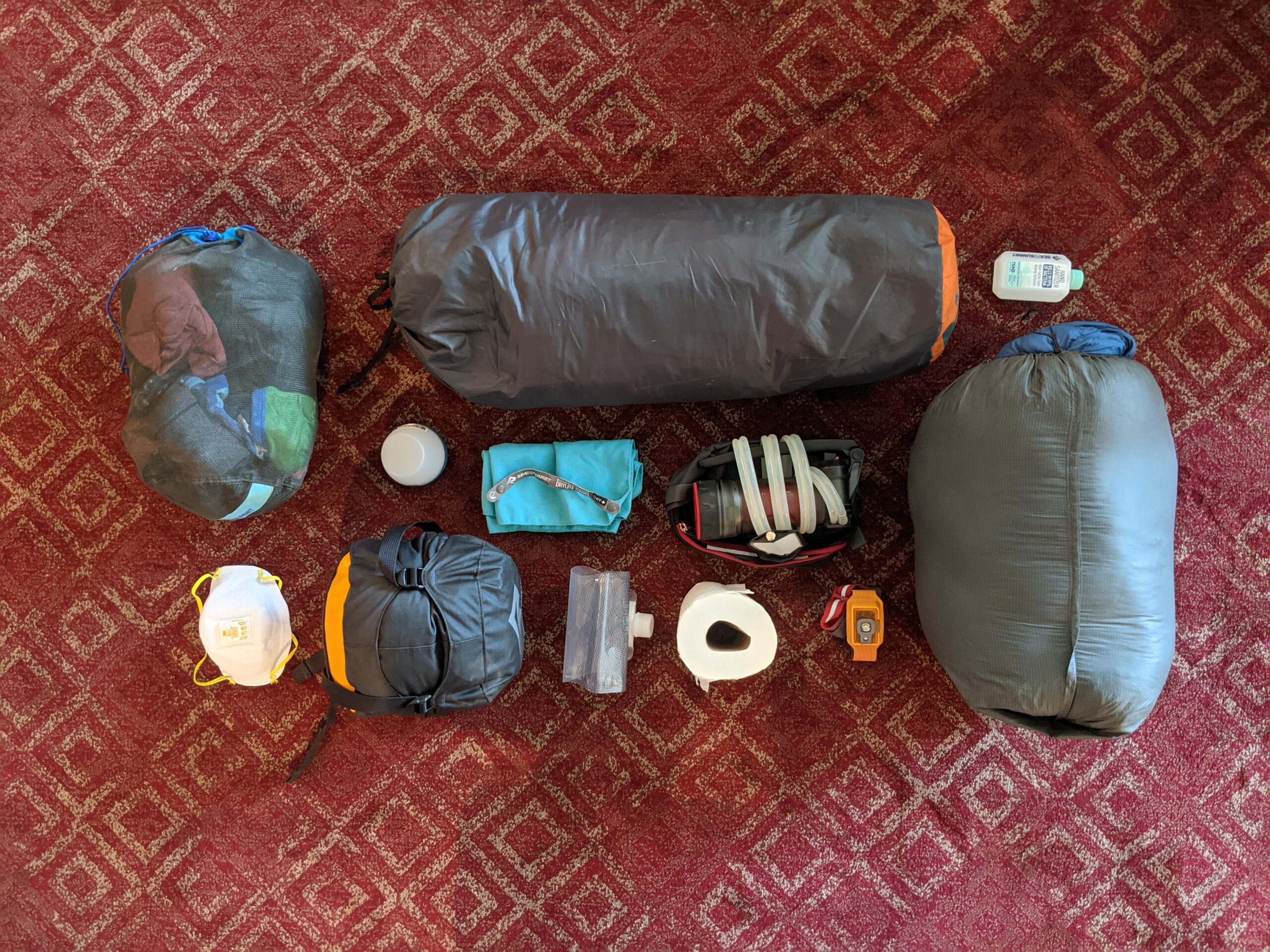The Best Red Dots for Shotguns of 2025, Tested and Reviewed
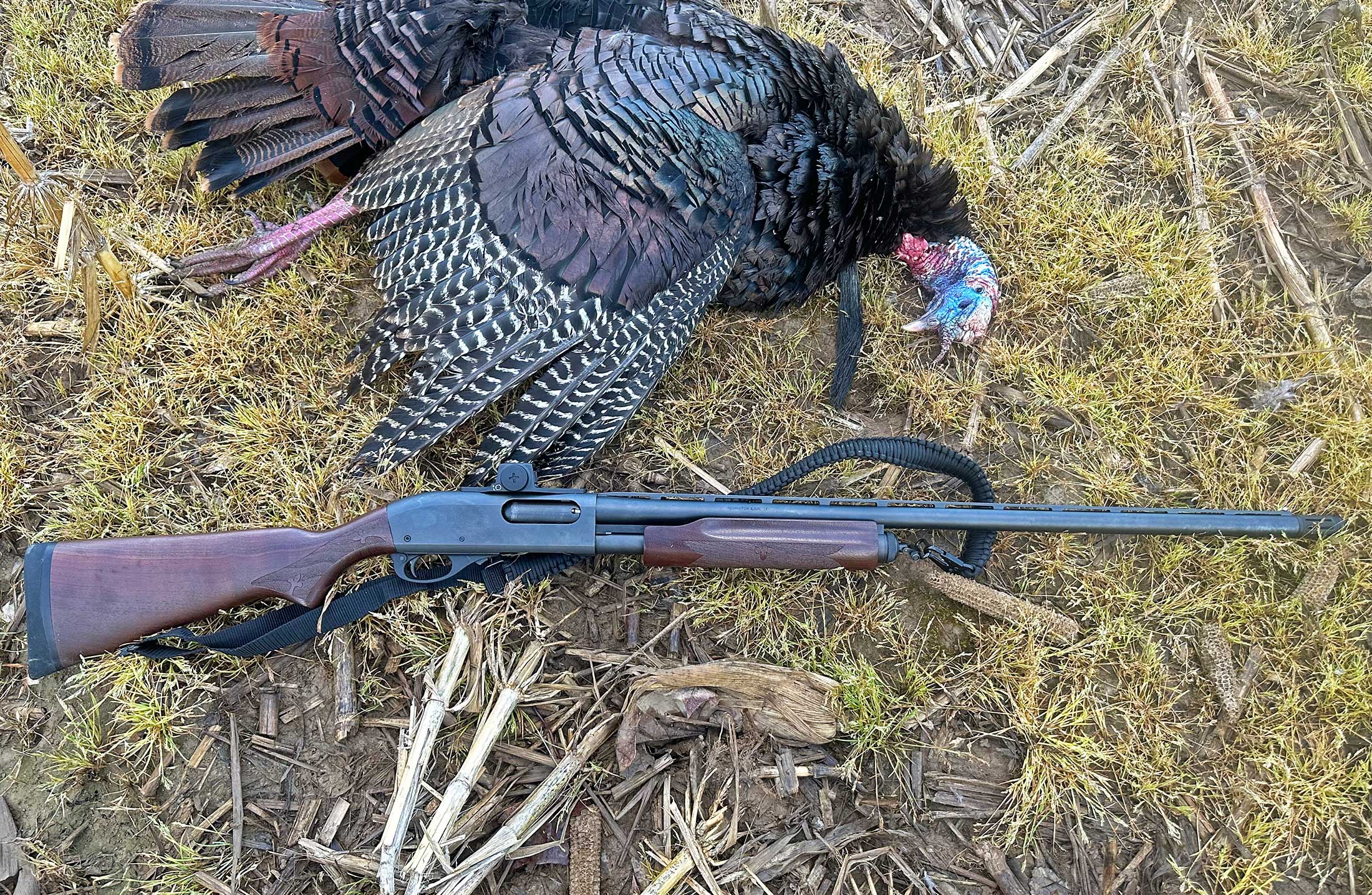
We may earn revenue from the products available on this page and participate in affiliate programs. Learn More ›
Just as red dot sights have become ubiquitous in the world of handgunning, more shotgun shooters are running red dots, too. With that, the best red dots for shotguns come in all manner of styles and designs.
You’ll see them on tactical and defensive shotguns, turkey hunting guns, and even some wingshooting guns.
So for the last few years, the other OL editors and I have been shooting every red dot we could get our hands on. A select few of them have proved to be perfectly compatible with shotguns, and those are the sights I’ll highlight here.
Honorable Mentions
Best Red Dots for Shotguns; Reviews & Recommendations
Best Overall: Vortex Viper Shotgun Enclosed Micro Dot
See It
Pros
- Easily mounts directly to receiver
- Compatible with most popular shotguns
- Low profile allows for natural gun mount
Key Features
-
Style Reflex, closed emitter -
Mounting Mounts directly to drilled/tapped receiver, two to three screws -
Window Size .87 inches (W) X .69 inches (H) -
Windage and Elevation Adjustment Flat bit screws -
Brightness +/- toggle buttons (top of sight) -
Night-Vision Compatible? Yes -
Battery CR2032
Vortex’s Viper red dot is an enclosed emitter sight that’s cleverly integrated with a universal receiver mount. The design is so clean that it makes you wonder why nobody thought of it sooner. The Viper is built from a single piece of 6061 aluminum and it affixes directly to the receiver of most shotguns (find the list of compatible shotguns here). Because no rail or adapter is needed, the red dot sits close to the bore, which allows for a more natural gun mount and a solid cheek weld.
There are two Viper variations: one with a single 3-MOA dot and one with seven reticle options (it costs $50 more).
The Viper was designed for turkey hunters, but it also fits nicely on tactical shotguns and carbines that have drilled and tapped receivers (our shooting editor John B. Snow mounted one on a Henry Lever Action Supreme).
The one concern I had with the Viper design was if it would stay fastened to the receiver and hold zero, especially after getting rocked by heavy turkey loads. So I mounted one to a tactical shotgun and ran through a few boxes of magnum shells. Thankfully, the sight held zero. (You can read my full review of the Viper enclosed red dot here).
I’ve also mounted Viper red dots on a handful of turkey shotguns, including my Mossberg 500 .410 and a 12-gauge 870 Fieldmaster. In both cases the low profile housing made for a sleek little setup that was handy in the woods. I’ve killed turkeys with both rigs this spring and since both have held up nicely, I plan to shoot many more with them in the near future.
Best Open Emitter Sight: Trijicon SRO
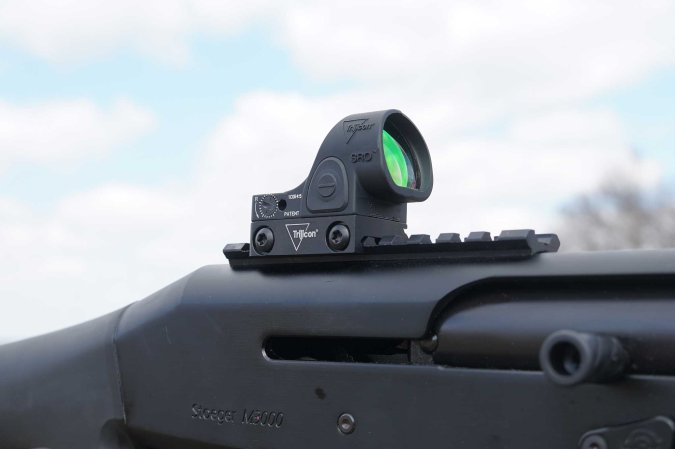
See It
Pros
- Large window, fast target acquisition
- Variety of dot brightness options
- Variety of dot size options
Cons
- Pricey
- No shake-wake feature
Key Features
-
Style Reflex, open emitter -
Mounting RMR footprint -
Window Size 1.0 inches (round) -
Windage and Elevation Adjustment Flat bit screws -
Brightness: +/- toggle buttons (left and right side of sight) -
Night-Vision Compatible? Yes -
Battery CR2032
I’ll admit that the Trijicon SRO (Specialized Reflex Optic) is a bit of an unconventional pick for the best open emitter to throw on a shotgun. A lot of folks would go with the iconic RMR Type 2 or maybe the Burris Fastfire 4, both of which are great red dots.
But in my head-to-head testing, I was enamored with how clear the sight picture was through the SRO. I found it to be fastest for target acquisition and for transitioning to another target.
And that makes sense as the SRO was designed specifically for competition pistol shooters who need to pick up targets quickly while shooting both fast and accurately. It has a large window and a thin housing so the sight doesn’t obstruct your field of view. Also, the SRO has a taller, circular window, which I found to be advantageous.
I gave the sight to editor Dac Collins to use during the Indiana turkey season and he put a beating on it, crawling around river bottoms and muddy fields in the rain. After several days of hard hunting, the SRO still ran like a champ, and I’m confident it will continue to do so for many seasons to come.
The SRO has eight brightness settings, including an auto brightness option. You make brightness selections with large buttons on the left and right of the sight that are easy to find and manipulate in a hunting scenario.
The only downside to this dot is that it doesn’t have a shake-wake feature, so you need to remember to turn it off — or change the batter every couple years. Overall, I think it’s an excellent option for a defensive shotgun, a dedicated turkey gun, or a crossover of the two.
Best for the Money (Open Emitter): Burris FastFire 4
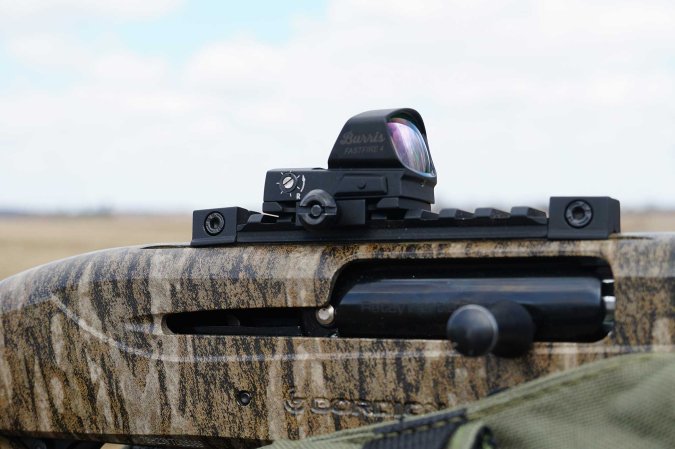
Pros
- Wide window is perfect for turkey hunting
- Includes weather shield
- Relatively low profile
- Auto on-off
Cons
- Brightness adjustments can be confusing
- Halo around red dot in bright conditions
Key Features
-
Style Reflex, open emitter -
Mounting Doctor footprint -
Window Size 1.10 inches (W) X .75 inches (T), measured -
Windage and Elevation Adjustment Flat bit screws -
Brightness: one button (left side) -
Night-Vision Compatible? No -
Battery CR1632
At $350, this is not a cheap red dot. But in all honesty, I don’t feel great about recommending any open-emitter red dot that costs less than two bills. On a turkey gun, the sight is going to take a serious beating. When mounted on a defensive shotgun, your life could depend upon the dot’s reliability. So you might as well spend a little bit more for a reliable sight that will last. And you can do that without throwing down $500 or more for a top-end model.
This brings us to the Burris FastFire 4. The wide window and thin housing on this dot provide an excellent sight picture. For target acquisition in the woods, I have not tested a sight that’s as fast and clean (except for the Trijicon SRO).
The version that I received had a picatinny rail mount included so attaching it to my Retay Gordion 20 gauge turkey gun was as simple as tightening a single bolt. While hunting with the Fastfire 4, I appreciated how it sat low on the rail. Compared to other large-window dots on the market, the Burris has a low profile, which helps with natural aiming. I used it to shoot a long beard on the opening day of turkey season here in Minnesota. One of my buddies, who is a brand-new turkey hunter, also used my rig to shoot his first bird ever. The fact that he could use the sight effectively right out of the gate earned the Fastfire 4 some bonus points.
The Fastfire 4 has four reticle options, which you toggle through by hitting the button on the right side of the sight (though I prefer the single red dot for hunting).
I have only two quibbles with the sight. The first is that while sighting in and shooting I noticed there was a halo around the red dot (like a remnant of the other reticle options). The other critique is that cycling the red dot brightness can be slightly confusing. There are three manual brightness modes and one auto brightness option. The problem was deciphering if I was in a manual setting or auto mode. Not the biggest problem, but for turkey hunting I like to be in manual mode.
Best for the Money (Enclosed Emitter): Vortex Crossfire
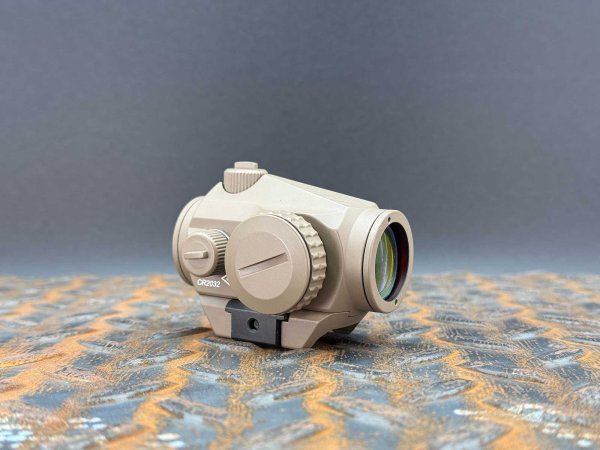
See It
Pros
- Affordable
- Compact
- High and low mounting options
Cons
- Must scroll through all brightness settings when turning optic on
Key Features
-
Style Reflex, enclosed emitter -
Mounting High and low Picatinny mounts -
Window Size 22mm (round) -
Windage and Elevation Adjustment Flat-bit screws -
Brightness 13 settings, adjustment wheel -
Night-Vision Compatible? Yes -
Battery CR2032
If you simply need an affordable red dot to throw on your turkey gun, the Vortex Crossfire is a great place to start. Priced at $150, it’s plenty affordable and it comes with Vortex’s VIP warranty which should give you some peace of mind. The Crossfire is a compact tubular reflex sight that runs off a single CR2032 battery. The Crossfire red dot’s brightness adjustment is via a knurled dial on the right side, which starts at zero (off), N1, N2, and one through eleven. Turning the knob clockwise increases the intensity of the dot. The battery is housed in this knob under a cap that’s removable with a coin. Senior staff writer Tyler Freel reviewed the Crossfire and his only complaint was that the brightness knob is pretty stiff, and there aren’t alternating “off” positions between settings. If you want to turn the optic off or on, you have to rotate through all the settings back to or up from zero.
The Crossfire comes with two different Picatinny rail mounts. The tall mount is excellent for AR-type carbines with low-sitting rails, but shotgun shooters will want to use the low mount.
Best for Wingshooting: Aimpoint Acro S-2

See It
Pros
- Mounts directly to shotgun rib (fits all popular shotguns)
- Large dot is easy to see quickly
- Promotes consistent gun mounting
Cons
- Sight housing obscures field of view
- Limited versatility
Key Features
-
Style Reflex, enclosed emitter -
Mounting Mounts directly to shotgun rib -
Window Size .75 inches (W) X .75 inches (H), measured -
Windage and Elevation Adjustment T10 Torx screws -
Brightness +/- toggle buttons (on left side of the sight) -
Night-Vision Compatible? Yes -
Battery CR2032
This red dot takes a bit more explaining. Unlike the other sights in this review, it’s designed specifically for clays and wingshooting. It mounts directly to the shotgun’s rib, and it has a 9-MOA dot (which is very large).
I put an S-2 on my Benelli Super Black Eagle 3 and the mounting process was incredibly simple. You measure the width and thickness of your rib (I used digital calipers) and then choose the correct mounting brackets, which are included . Then you sight in just like you would with any other red dot. Or, since the S-2 sits on your rib, you can also take the barrel off and bore sight quickly, to get started. It took me about five minutes to get my point of aim and point of impact lined up on a patterning board.
However, getting comfortable shooting the S-2 took me a bit more time. I grew up shooting birds on the wing, so I’m used to focusing on the target, mounting the gun, and shooting — without ever really looking at the bead. Theoretically, you’re supposed to do the same thing with the red dot in the Acro.
But because the sight is a little blocky, I found myself picking up targets more slowly than I would without the dot. I could see this being especially challenging with long crossing shots, which need more lead.
However, I do see the value of the S-2 as a training tool for new shooters. Since you must have your head on the gun to see through it, it helps teach a proper and consistent gun mount and cheek weld. I could also see it being absolutely deadly on targets flying straight away.
I definitely need to shoot with the sight more before passing final judgement. But I will give full credit to Aimpoint for making a clever, stout little wingshooting red dot for those who want one.
Best Holographic: EOTECH XPS2
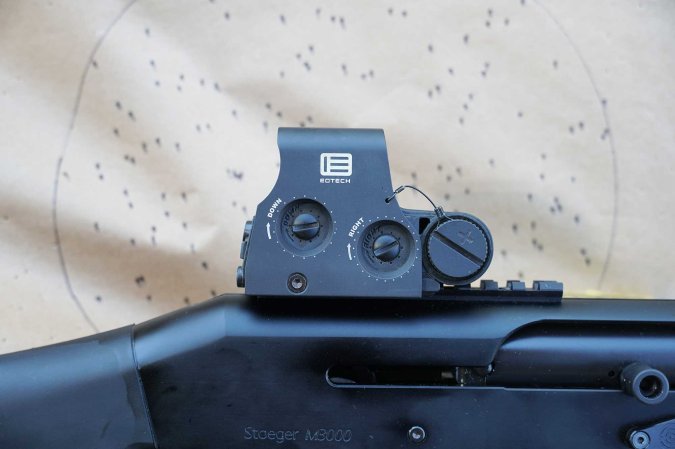
Pros
- Excellent sight picture and clarity
- Rugged and durable
- Wide variety of brightness settings
- Simple mounting and sight in
- Made in the USA
Cons
- Not night vision compatible
- Relatively bulky compared to other red dots
- Shorter battery life
Key Features
-
Style Holographic -
Mounting Picatinny rail mount -
Window Size: 1.3 inches (W) X 1 inch (T) -
Windage and Elevation Adjustment Flat bit screws -
Brightness: two buttons (20 settings) -
Night-Vision Compatible? No -
Battery CR123 battery
The benefit of an EOTECH holographic sight is that it provides a large sight window with no blue/green tint or glare (which is common among the other sights in this review). If a wide, clear sight picture matters most to you, you should consider a holographic sight.
It’s also a bombproof optic, especially compared to those little open emitter red dot sights which can be compromised by nasty weather conditions. The downside is that it’s a bigger unit to mount on your shotgun. The XPS2 is the shortest and lightest (9 ounces) sight that EOTECH offers. This is the non-night vision version, (since night vision isn’t needed for most hunting or home defense applications anyway). But if you need night vision compatibility, you can opt for the more expensive Eotech EXPS3 HWS.
I ran the XPS2 on my turkey hunting shotgun during the 2024 season and found it to be super easy to install, sight in, and use. I loved the view through the sight and appreciated the basic and positive functionality of the brightness settings and adjustment dials. I hauled this sight through the woods and dragged it through the mud and it never faltered. The protective aluminum hood gave me confidence that the optic will hold up for a long time. While it’s not exactly a sleek sight, I did get used to it on my shotgun and will definitely be hunting with it in seasons to come.
The only other downside with this sight is that it has relatively shorter battery life than general red dots. EOTECH says it will run for about 1,000 hours “at nominal setting 12 at room temperature.” That’s about 42 days, compared to 3-plus years for most red dots. The point: just remember to turn it off.
More Red Dot Sights for Shotguns
There are a ton of other great red dot sights for shotguns, and a few deserve consideration here.
Holosun 507 Comp: A large open-emitter sight with a bunch of reticle choices.
Bushnell RXM 300: An affordable open-emitter that offers top-end features.
Trijicon RMR Type 2: An all-around excellent open-emitter that has a proven track record.
Trijicon MRO: A heavy-duty enclosed emitter that offers a ton of reliability.
Leupold Deltapoint Pro: A classic and versatile open-emitter with a wide window.
Sig Romeo5 Gen II: An affordable enclosed-emitter that will get you in the red dot turkey hunting game.
How I Picked the Best Red Dots for Shotguns
Over the last several turkey hunting seasons I’ve hunted with about a dozen different red dots on a variety of shotguns. During our review of the best shotguns for home defense, we ran a handful of top red dots through basic shotgun drills on a flat range.
And this spring, I threw dots on tactical shotguns and practiced mounting and shooting quickly (IPSC targets at about 10 yards).
Plus, senior staff writer Tyler Freel recently reviewed a whole arsenal of the best red dot sights on handguns and carbines. I took all of these experiences into account when making my picks here.
In all cases, I evaluated dots on their ease of use, mounting options, optical clarity and sight picture, and perceived durability.
What to Consider When Picking the Best Red Dot for a Shotgun
The perfect red dot sight for a shotgun would sit low on the receiver, it would have a large and clear window, it would have minimal housing to not impede your view, it would be infinitely durable, and it would be easily affordable.
Since we live in an imperfect world, you’ve got to choose the qualities that are most important to you.
Generally speaking, open-emitter sights have smaller profiles and sit lower on the gun. Enclosed-emitter sights tend to fare better in rugged conditions and inclement weather.
In all cases, you get what you pay for. In other words, it makes good sense to buy once, cry once when shopping for a red dot (or any optic).
Final Thoughts on the Best Red Dot for Shotguns
Shotgun shooting, by its very nature, is an imprecise pursuit. However picking the right red dot to pair with your shotgun can help with better aiming, faster target acquisition, and more accurate shooting. And once you start shooting and hunting with a red dot, you’ll never want to go back.
Read the full article here







